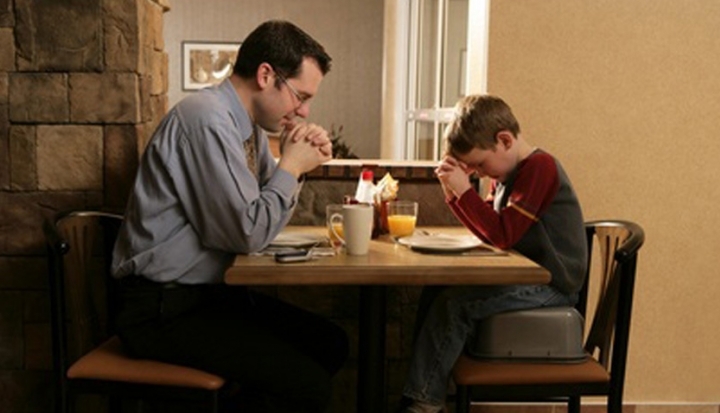Whether you’re a parent or a volunteer catechist, this theologian says the art of persuasion is key to handing on the faith. Want proof? Just watch Jesus in the gospels.
Thomas Groome learned this truth somewhat late in life: Even if you have been a major scholar in the field of religious education for decades, even if you speak internationally on the subject of handing on the faith, and lo, even if you are the primary author of three major catechetical series used by millions of children and young people, your own child will always be your toughest audience.
“I have to confess that at almost 12 years old, like many kids, he already hates coming to church with us,” says Groome of his son. “We’ve warned him that he’ll come until he’s 18. But he loves coming to the Catholic Worker soup kitchen in downtown Boston with me. We only go occasionally, but it’s often at his suggestion.”
After consistently maintaining that parents are the primary religious educators of their children, Groome found himself writing that children can be the primary religious educators of their parents.
“I hadn’t abandoned my first conviction,” he says, “but I’d found the reverse to be true as well. Some of the experiences I’ve had with my son have been enormously enriching to my own faith life and my wife’s as well.
“Of course there are no guarantees that what we’re doing as parents will take. But by the grace of God, you hope for the best. Being a father certainly made me humble about how to talk to parents, and yet all the more convinced of the opportunities we have as parents.”
Given the latest statistics on disengaged and departed Catholics, some say our system of passing on the faith has fallen apart. Religious educators often get the blame. After 30 years in this field, what do you think?
I see that as totally false. We’ve never had surefire ways of handing on this faith.
We keep thinking that the Baltimore Catechism was a great way to hand on the faith, but it wasn’t at all. That catechism, which was standard in Catholic schools in the United States from the 1880s through the 1960s, had 422 questions and answers, a great number of which were totally irrelevant to people’s lives. There were seven questions and answers on how to gain an indulgence, 11 questions and answers on limbo and purgatory. And none on the meaning of Easter except for, “On what day did Jesus rise from the dead?”
We have to realize that for about the first 1,500 years of the church, people were inculturated into the faith by familial, social, and cultural structures. A small percentage went to a monastic or a cathedral school, usually the elite. The only form of instruction that the common people had was the liturgy; they learned to recite the Nicene and the Apostles’ Creeds, the Our Father, and the Ten Commandments. For at least 1,500 years, that was about as much formal education in faith as 98 percent of people received.
Then along came the Protestant Reformation. Suddenly whether you believed in two sacraments or in seven could decide which side you fought on when the wars broke out or who you paid your taxes to after the wars ended.
So accuracy regarding what we believe became a socio-political issue. Martin Luther came along and wrote his Small Catechism, an easy-to-memorize question-and-answer summary.
What did the Catholic Church do?
We followed suit and wrote our own catechisms. We thought that we were handing on the faith, but what really taught us the faith was our parents and our grandparents teaching us to pray and teaching us to follow the way of Jesus and devotions to the Blessed Mother. We learned about feast days and fast days and all the other practices of faith that nurtured us, be it in the family or in the parish.
People say, “We used to know our faith but we don’t anymore.”
Well, if you were raised with the Baltimore Catechism, you didn’t really know your faith. And of course, apart from the catechism, we were biblically illiterate. There are three quotes from the scriptures in all of the Baltimore Catechism. There was a famous study done back in the 1960s showing that 85 percent of Catholics asked to name the authors of the four gospels could not do so; neither did they know other very basic things about the Bible.
Today it’s a different world. It’s a terribly challenging time. But as Cardinal Jean-Marie Lustiger, the former archbishop of Paris, often pointed out, it’s a very challenging time for faith, but it’s also a marvelous and a wonderful time for a chosen faith, for a faith that is not simply socialized but that is held with conviction and commitment in the context of everyday life.
For that kind of a living faith, it’s a marvelous time. But we will have to go about doing things differently, especially our catechesis.
How so?
I think there are clues in how Jesus went about it. He had this amazing way of deeply engaging people’s everyday lives. The parables are classic examples. “The reign of God is like a woman who lost a coin.” I always imagine he was talking to the women at the well. “The reign of God is like a sower who went out to sow some seed.” He was talking to a bunch of farmers. “The reign of God is like fishermen sorting their fish.” I bet he was talking to the fishermen down at the lake.
Besides beginning with people’s lives, Mark, at the beginning of his gospel, says Jesus taught “with authority.” He wasn’t just a discussion leader. He brought people from life to faith, to the gospel, and invited them to bring faith back to their life again. The call to discipleship was always present; Jesus enticed people to take that on, and made them great promises if they did.
He says, “I am the light of the world. And if you embrace this light and follow this way, you will have light and life.” And also, “I am the good shepherd. But if you come follow me, you will find life abundantly.”
In other words, he was always persuading, enticing, inviting people to take it to heart, to put it to work even for their own benefit. Very seldom does Jesus make a statement about himself in which he didn’t lay out the implications for us as disciples. That call to discipleship was always there.
So after writing lots of big, heavy books about it, I finally figured out that Jesus’ approach was to bring life to faith and to bring faith to life.
What do you think is the best example of this in the gospels?
The classic example is the story of the disciples on the road to Emmaus. Jesus appears to the two disciples but never tells them who he is. Instead he walks along with them and asks, “What’s going on? What’s happening in your life?”
They’re taken aback: “Where have you been? Are you the only one in Jerusalem who doesn’t know the things that went on there these past few days?” But then he says, “What things?” Nobody knew better than he what had gone on in Jerusalem those past few days, and yet he wants these people to tell him about their pain, their loss, their trauma, their shattered vision, their life.
And so they lay out their lives and the pain of it, they reflect on it, they share it. And only then does Jesus turn to the tradition. Beginning with Moses and all the prophets, he interprets for them every passage of scripture that referred to himself and explains that the Messiah had to suffer so as to enter into his glory.
He lays out the whole faith tradition pertaining to himself and yet does not tell them what to see. He spends time with them and shares a meal with them, in which, of course, they come to recognize him. And then he disappears because, in some ways, his work is done.
But now, what do the disciples do? They turn around and they head for Jerusalem to reengage the faith community. They’ve come to see for themselves.
I think that’s what Cardinal Lustiger was talking about. If we can get people to come to see for themselves the richness of this faith tradition, how it can be integrated powerfully into ordinary, everyday life, then I think people will indeed be tempted to not just head on home.
I love how the Jerusalem Bible translation ends it: “Then they told their story of what had happened on the road and how they had come to know him in the breaking of the bread.” I suppose all catechesis has really arisen from ordinary people of faith telling our stories of what happened on the road and how we have come to know him in the breaking of the bread.
That’s what parents and grandparents and aunts and uncles did for 1,500 years, and have gone on doing, of course. And to the extent that we continue to do it well, I think, there will be faith.
What do you think of telling parents today, “You are your child’s primary religious educator”? Isn’t that line often met with a less than confident response?
See, the problem is that parents hear “educator” and immediately they think “school” and that they have to begin instructing their child as if they’re teachers. But this phrase does not mean formal, doctrinal teaching by parents. It really means the family should function as kind of a domestic church. This means that the environment of the home, its values, its language patterns, and its lifestyle have to be suffused with Christian values even though you’re not talking explicitly about God all the time.
In other words, let’s remember the rituals: morning prayers, night prayers, prayers before and after meals, what we put on the walls of our homes, getting a blessing as you go out the door. People have given up on some of these old rituals, but I don’t think it’s possible to raise a child in the faith without them. Even if you don’t go for the old ones, you’ll have to find new ones. And beyond the kindness and justice of the family toward its own members, don’t forget the family’s outreach with works of justice to the community as well.
It takes imagination to raise children in the faith. It doesn’t necessarily take an awful lot of time. But if you get that basic conversion, that initial conviction that God loves me, for example, that’s what you can build on.
So when people say to me, “Oh, what faith will I pass on?” I say, “Your own.”
What about the ever popular Catholic motivator, guilt, to spur parents on?
A bit of guilt might not be too bad. But let’s give people the resources, the suggestions, the networking, and maybe a bit of the guilt that prompts them to be responsible. Tell them you can’t delegate this to somebody else. You can’t drop the kid off for one hour once a week, go grab the groceries, and come back and expect to have a Christian ready to take home. You can’t expect that somebody else will make a Christian for you.
In some ways the church is reaping what it sowed. We often made parents insecure in their ability to teach, in ways that our Jewish brothers and sisters never did. One of my Jewish students got fed up with the Catholic students who were badmouthing their parents for being divorced and remarried and not going to church and so on. “I prefer parents to keep kosher, I prefer them to come to synagogue,” she said. “But whether they do or not, we expect them to hand on their Jewish identity to their children, and they do.” They pass on the faith in the home around Sabbath meals, Passover meals, festivals like Sukkot, the holy days of Rosh Hashanah and Yom Kippur. The parent is still the primary educator in faith in the Jewish community.
Tragically Christians left that behind when we left the synagogue. And we gave it over to formal instruction and teachers and schools and programs. I’m not opposed at all to good religious education; in fact, I’ve spent my life trying to promote it. But, to use Paul’s phrase to the Corinthians, “households of faith” is what we need. We have to encourage young parents’ faith, give them suggestions. Stuff that our grandparents did automatically, we have to instruct young parents how to do it now.
How does doctrine fit into that?
The Catechism of the Catholic Church in its opening pages states that faith is assent to the stated doctrines officially taught by the Catholic Church. But faith demands much more than that. It demands a celebration of the sacraments, participation in the moral life, the teachings of Jesus. “If you live according to my teachings, you’re truly my disciples, then you’ll know the truth that sets you free.”
In other words, if it’s lived faith, then it’s much more than a confession of beliefs. So preparing people to live it rather than simply to know about it is imperative.|
We need to know about it, of course, to understand it and comprehend it and to make good judgments and decisions out of it. But that’s only the beginning, or maybe that’s more the end of the beginning. In that sense I even think there are certain dogmas and doctrines and lists and symbols of faith that Catholics should still know by heart.
Can you tell us some of them?
The Ten Commandments, the seven sacraments, the Nicene and Apostles’ Creeds, the Our Father, the Hail Mary. And some of the doctrinal statements: the divinity and humanity of Jesus, the Blessed Trinity, one God in three divine persons and yet the unity of the Godhead. The effectiveness of the sacraments. The moral teachings and social doctrine.
I think the seven corporal and spiritual works of mercy are worth knowing, because they’re a prelude to a commitment to social justice. Also people should know some of the great social and ethical principles.
And then I think there’d be key scripture passages that people should know by heart: John 3:16, for example (“For God so loved the world…”), and the witness of Peter that Jesus is the Messiah (Matt. 16:16). Also Martha’s confession in John’s gospel that Jesus is the Messiah (John 11:27), and the story of Mary Magdalene being the first witness to the resurrection in John chapter 20.
I don’t know how many you’d end up with, but I think it would help for Catholics to know them by heart.
What do you think will attract people to the message of Christ today?
Nothing is ever true simply because the church says so. It’s always true for a better reason, which of course is why the church says so.
The threat of hell, the promise of heaven, even if that worked at one time, I don’t think it’ll work anymore. Young people today are not interested in going to heaven. They’re interested in going to college next year.
We’ve also come to believe in the unconditional love of God. You can reject that love, of course. But we’ve moved out of an era when the church proclaimed that 90 percent of people were going to hell. That kind of threat has lost its sting.
I was fascinated by the approach that Pope Benedict XVI used when he met with young people while on his 2008 trip to the United States, which was one of persuasion. He asked the young people, in essence, “Do you want to be truly free? Do you want to live a wonderful life? Do you want to be a marvelous human being?” And they all shouted, “Yes!”
And then he’d say, “Well, follow Jesus Christ!” In other words, this is a wonderful way to live your life. When Jesus said, “I am the way, the truth, and the life,” he wasn’t kidding. This is a great way to live your life. It is its own reward. We are capable of a tremendously positive kind of persuasive rhetoric that actually is not new at all. It’s as old as the church itself.
When you look at the old apologists at the beginning of the church, it was all by persuasion. Look at Jesus. It’s all by persuasion: “If you follow me, you will have life abundantly.” “Abide in me, and I will abide in you, and God will abide with us, and you’ll have life eternal.”
As a parent yourself, what advice would you give to parents about handing on their faith?
I was talking to a colleague not long ago, a theologian. He was complaining about how ineffective his parish catechetical program is, and how his kids are learning nothing about their faith.
After a bit of this I turned to him and said, “Why don’t you catechize them yourself?” It was as if I’d hit him in the stomach. But why would he presume that some poor volunteer catechists in the parish could do a better job than he? I mean, he has the responsibility himself.
So the responsibility that we have as parents has really come home to me all the more vividly through my son.
Read more of our interview with Thomas Groome: Tips for raising Catholic children and Is secularism standing in the way of raising our kids Catholic?
This article appeared in the February 2013 issue of U.S. Catholic (Vol. 78, No. 2, pages 18-21).
Image: Vibe Images/Fotolia.com













Add comment